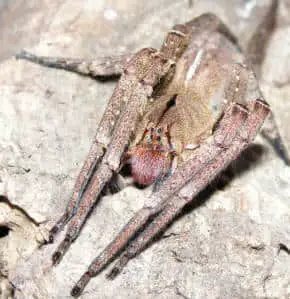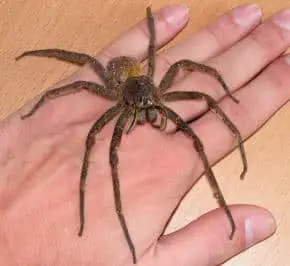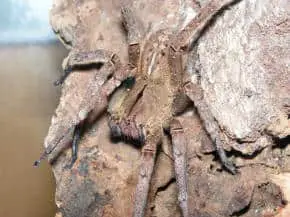Phoneutria spp. is actually a genus with five known similar species whose members are highly venomous. They include some of the relatively few species of spiders that present a threat to human beings. The Brazilian Wandering Spider (Phoneutria fera) can grow to have a leg span of up to 4-5 inches.
These spiders are notorious both due to their toxic venom, and because they are not reluctant to attack people who appear threatening.
Of the five species known, P. nigriventer and P. fera most frequently receive mention in mass-media publications. P.nigriventer species are responsible for most cases of venom intoxication in Brazil because this species is commonly found in highly populated areas of Brazil, namely the South-eastern states: São Paulo, Minas Gerais, Rio de Janeiro and Espírito Santo.
The P. fera is native to the northern portion of South America, especially the Brazilian Amazônia, Venezuela and French Guiana.
Photo right:


Recent studies suggest that these spiders only inject venom in approximately one-third of their bites and may only inject a small amount in another third. However, research in this area is hindered by the difficulty of identifying particular subspecies. Thus the effects of the bites from these spiders are hard to predict when based on sketchy information or if the spider has not been identified definitively.
Bites from these spiders may result in only a couple of painful pinpricks to full-blown envenomation. In either case, people bitten by a Phoneutria or any Ctenid should seek immediate emergency treatment as the venom is possibly life threatening.
The Phoneutria fera and nigriventer are the two most commonly implicated as the most virulent of the Phoneutria spiders. The Phoneutria not only has a potent neurotoxin, but is reported to have one of the most excruciatingly painful envenomations of all spiders due to its high concentration of serotonin.
Brazilian Wandering Spiders are extremely fast, extremely venomous, and extremely aggressive and are ranked among the most venomous spiders known to man. In fact, the Brazilian Wandering Spider is the most venomous spider in the New World! In South America, these true spiders are commonly encountered in peoples’ homes, supposedly hiding in peoples’ shoes, hats, and other clothes. It does not remain on a web, rather, it wanders the forest floor, which is how it got its name.

The Brazilian Wandering Spider has another name – the Banana Spider and it was given this name because there have been cases where these spiders unintentionally appeared on banana boats heading for the United States.
Click here for more photos of Wandering Spiders.
Information and pictures were taken from children’s projects and where credited to that child does not claim to be original information. Where possible, permission to reproduce has been sought. Any infringement of copyright is purely unintentional.
